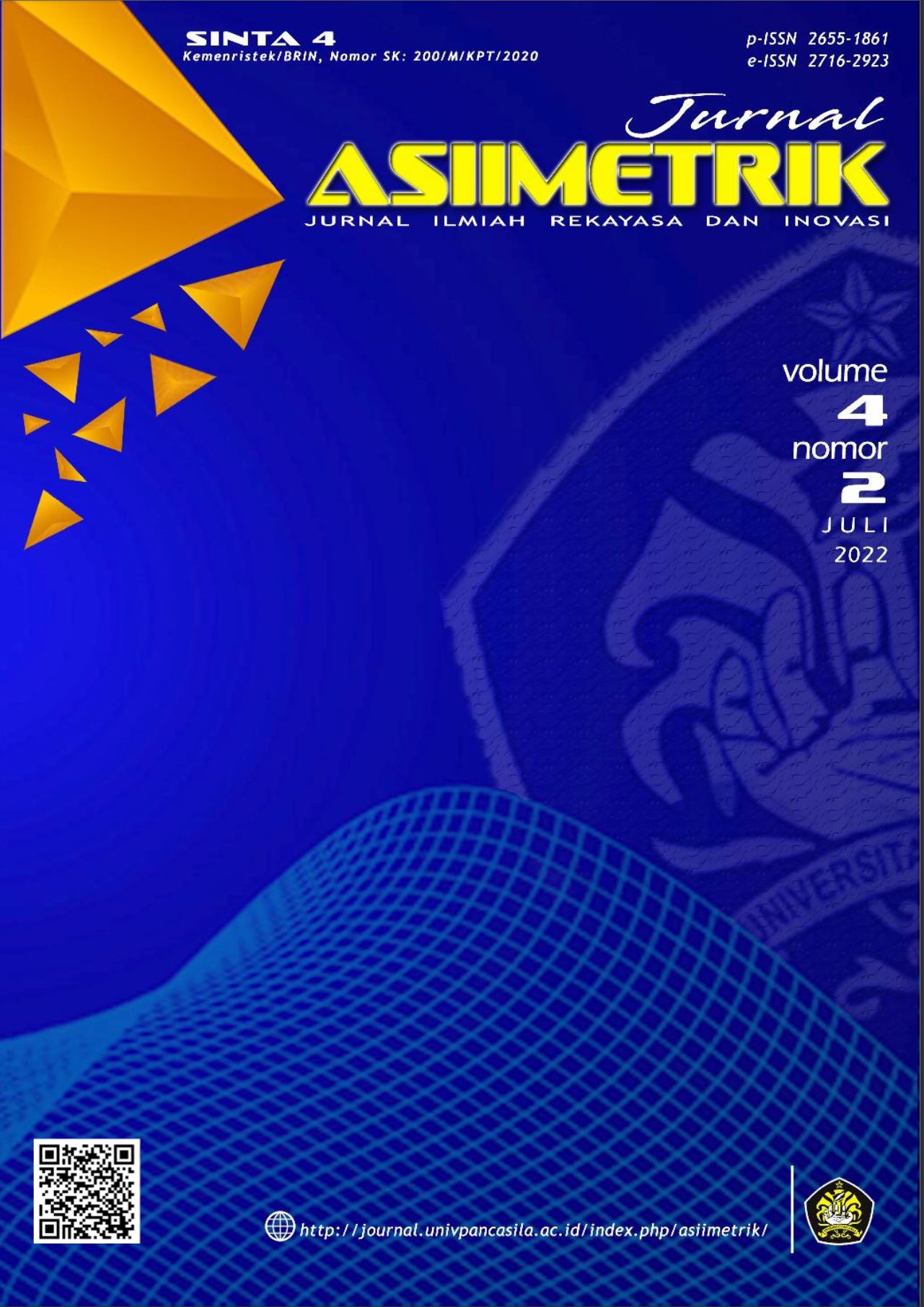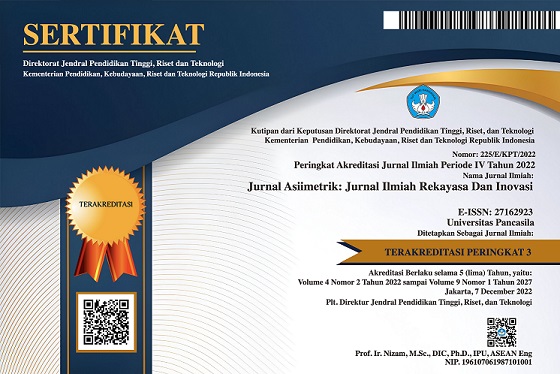Karakteristik Kekerasan Lasan Titik Gesekan dan Pengadukan pada Paduan Aluminium 5052-H112
DOI:
https://doi.org/10.35814/asiimetrik.v4i1.3183Keywords:
friction stir spot welding, hardness-Vickers, temperature distributionAbstract
Issues in friction stir spot welding focus mainly on the mechanical characteristic affected by its Hardness. This Hardness must be maintained by evenly temperature distribution in weld zones during welding. The process parameters are mainly responsible for the development of the hardness of the friction stir spot weld. This study presented the hardness evaluations on the friction stir spot weld via the Hardness-Vickers test and analysis of the temperature distribution in the weld zones via the finite element method. The workpiece samples used in this study were Aluminium alloy 5052-H112 with a thickness of 2 millimeters in the lap-shear mode based on 3 main parameters at low and high levels of parameters configuration. The results obtained via the Hardness-Vickers tests exhibited a value of 42-HV located in the middle of the spot-weld center using a low-level parameters configuration. This value increased to 64-HV around the vicinity of the keyhole. And then the value decreased to 53-HV outside the keyhole, about 6 millimeters from the spot-weld center. Using high-level parameter configuration, the Hardness-Vickers value increased to 61-HV in the middle of the spot-weld center. The value then increased to 76-HV in the vicinity of the keyhole. Furthermore, the value decreased at 60-HV outside the keyhole, which ca 6 millimeters away from the spot-weld center. The temperature distribution of the weld zones achieved 480 oC in the vicinity of the keyhole using the low-level parameter configuration. Slowly, the temperature declined to 380 oC at 6 mm away from the friction spot-weld center in the HAZ. Using the high-level parameters configuration, the temperature distribution reached 540 oC in SZ, and slowly reduced to 425 oC in HAZ. Based on the results, it was found that by using high-level parameters configuration the hardness of the friction stirs spot weld exhibited better Hardness-Vickers value and evenly temperature distribution in the weld zones.
Downloads
References
Akinlabi, E.T. dkk. (2020) ‘Data on microhardness and structural analysis of friction stir spot welded lap joints of AA5083-H116’, Data in brief, 33, hal. 106585.
Almanar, I.P. dan Hussain, Z. (2011) Basic Considerations for Weldment Formation in Friction Stir Welding. Nova Science Publishers, Incorporated.
ASTM, American Society for Testing and Materials (1991) Standard Practice for Statistical Analysis of Linear or Linearized Stress-Life (S-N) and Strain-Life (ε-N) Fatigue Data. Available at: https://www.astm.org/e0739-10r15.html (diakses: 5 April 2022).
Burns, T. (2014) ‘Characteristics of Heat Treatable vs. Non Heat Treatable Aluminum Alloys’, Fabricating and Metalworking, 25 February. Available at: https://www.fabricatingandmetalworking.com/2014/02/characteristics-of-heat-treatable-vs-non-heat-treatable-aluminum-alloys/ (diakses: 5 April 2022).
Dursun, T. dan Soutis, C. (2014) ‘Recent developments in advanced aircraft aluminium alloys’, Materials & Design (1980-2015), 56, hal. 862–871.
Elangovan, K. dan Balasubramanian, V. (2008) ‘Influences of tool pin profile and welding speed on the formation of friction stir processing zone in AA2219 aluminium alloy’, Journal of materials processing technology, 200(1–3), hal. 163–175.
Haghshenas, M. dan Gerlich, A.P. (2018) ‘Joining of automotive sheet materials by friction-based welding methods: A review’, Engineering science and technology, an international journal, 21(1), hal. 130–148.
Jambhale, S., Kumar, Sudhir and Kumar, Sanjeev (2015) ‘Effect of process parameters & tool geometries on properties of friction stir spot welds: a review’, Universal Journal of Engineering Science, 3(1), hal. 6–11.
JSA, Japanese Standards Association (1999) ‘Specimens Dimensions and Procedure for Shear Testing Resistance Spot and Embossed Projection Welded Joints’, Japanese Standards Association. Japan, JIS (3136). [Cetak].
Jun-Won, K. dkk. (2012) ‘Influence of tool plunge depth and welding distance on friction stir lap welding of AA5454-O aluminum alloy plates with different thicknesses’, Transactions of Nonferrous Metals Society of China, 22, hal. s624–s628.
Kou, S. (2003) ‘Welding metallurgy’, New Jersey, USA, 431(446), hal. 223–225.
Mishra, R.S. dan Ma, Z.Y. (2005) ‘Friction stir welding and processing’, Materials science and engineering: R: reports, 50(1–2), hal. 1–78.
Muhayat, N. dan Putra, B.P. (2019) ‘Mechanical properties and microstructure of friction stir spot welded 6082-T6 Aluminium alloy joint’, in MATEC Web of Conferences. EDP Sciences, hal. 01005.
Padmanaban, R. dkk. (2016) ‘Process parameters effect on the strength of Friction Stir Spot Welded AA6061’, ARPN Journal of Engineering and Applied Sciences, 11(9), hal. 6030–6035.
Pan, T.-Y. (2007) ‘Friction stir spot welding (FSSW)-a literature review’, Transactions Journal of Materials and Manufacturing, V116(5), hal. 1-12.
Patel, V.V. dkk. (2016) ‘Effect of tool rotation speed on friction stir spot welded AA5052-H32 and AA6082-T6 dissimilar aluminum alloys’, Metallography, Microstructure, and Analysis, 5(2), hal. 142–148.
Piccini, J.M. dan Svoboda, H.G. (2015) ‘Effect of the tool penetration depth in Friction Stir Spot Welding (FSSW) of dissimilar aluminum alloys’, Procedia Materials Science, 8, hal. 868–877.
Sitthipong, S. dkk. (2018) ‘The influence of parameters affecting mechanical properties and microstructures of semi-solid-metal 7075 aluminum alloy by using friction stir spot welding’, Engineering Journal, 22(3), hal. 51–64.
Steels, A. (2013) ‘Aluminium Alloy Data Sheet 5052’. Available at: https://www.atlassteels.com.au/documents/Atlas_Aluminium_datasheet_5052_rev_Oct_2013.pdf. (diakses: 5 April 2022).
Yang, X.W., Fu, T. dan Li, W.Y. (2014) ‘Friction stir spot welding: a review on joint macro-and microstructure, property, and process modelling’, Advances in Materials Science and Engineering, 2014.
Yuan, W. dkk. (2011) ‘Effect of tool design and process parameters on properties of Al alloy 6016 friction stir spot welds’, Journal of Materials Processing Technology, 211(6), hal. 972–977.
YÜKLER, A.İ. dkk. (2018) ‘The optimization of welding tool material and welding parameters in friction stir spot welding of plastics using Taguchi experimental design’, International journal of Engineering science and application, 2(2), hal. 47–53.
Zhang, Z. dkk. (2011) ‘Effect of welding parameters on microstructure and mechanical properties of friction stir spot welded 5052 aluminum alloy’, Materials & Design, 32(8), hal. 4461–4470.





























